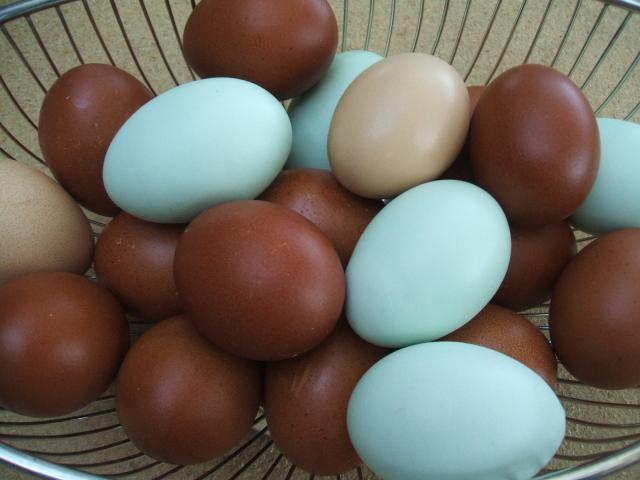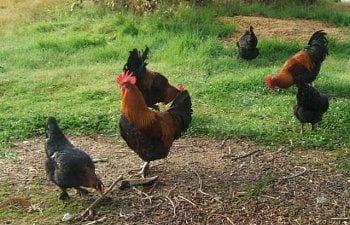Updated 2010-03-20
The Black Copper Marans
I have a small flock of Black Copper that I got from Bayhorsebonne who is a breeder of the Black Copper, Wheaten and Cuckoo varieties of Marans. My Black Copper Marans flock is now in it's second generation and the egg color is about the same as the first generation, except that now I get some very nicely stippled eggs occasionally. They have a coop that I built for them, but when I am around, I let them out to free range. They always come back to me when I call them and as soon as the sun goes down they make a dash for their coop and put themselves to bed. They are really easy and a pleasure to be around. The third generation chicks are due to hatch at the end of March. I am selecting for egg color and hoping I will see some improvement in each generation.
Black Copper Eggs
Breakfast Eggs

At the Greater California Poultry Fanciers Show-2009

With Easter Egger and Barred Rock Eggs


Black Copper Chicks



Grazing in the afternoon, 15 Weeks:

Cockerel 22 Weeks

22 Weeks

Pullet 23 Weeks

Pullet 23 Weeks

Excerps from the Description of the Brown-red Marans from the Marans Club of France:
Description of the Brown-red Marans
* - the cock must be "black with copper finery, the lancets of the hackle and of the small of the back which are widely copper-red edged, and a black or lightly reddish-brown marked breast."
* - the hen must be "black with not too many glints, with a coppery hackle and a black or lightly reddish-brown marked breast."
The precision of the vocabulary which is used is very important. We can also notice that the hackle mustn't be golden but coppery, that the cock breast is reddish-brown spotted and not enamelled. The hens have a black breast and not necessarly with reddish-brown glints like the cocks because it can create in the end, an unbalance of the Brown-red color due to an excessive dominance of undesirable golden glints on the hen back and wings. So the ideal compromise consists in seeking and preserving by a rigorous selection, a perfect balance between black excess and coppery excess. It must be understood that this balance of the Brown-red color was to be characteristised in the following way in the farmed cocks :
* - a sufficiently strong coppery color (but not excissevely black) and with red-colored shoulders
* - a slightly coppery marked breast
* - a black breast but only if the shoulders and the "ear-tufts" are good
* - orangery-red eyes and quite clear tarsus
As for the hens, the color rule is the same that fot the cocks.
The French Official Standard of the Marans Breed
A- GENERALITIES
Origin- Marans, town of the Atlantic coast, near La Rochelle (France).
Very big, from about 65 grams for young hens to 70-80 grams for adult ones. Deeply dark-brown coloured shell.Characteristics of the eggs to be hatched-
22 millimetres; Cock:
20 millimetres Hen :
Wheight Cock : 3,5 to 4 kilos;young Cock 3,0 to 3,5 kilos
2,6 to 3,2 kilos; young hen: 2,2 to 2,6 kilos Hen:
B – DESCRIPTION OF THE MARANS FOWLS AND AIMS OF BREEDING THEM
Fairly strong poultry, of an average size, plumage close to the body, giving an impression of strength without looking heavy and awkward. The best eggs must be very big and dark-brown coloured.
C – STANDARD
General appearance
Cock
strong, fairly long and wide especially near the shoulders which are highly posted Body-
long, fairly strong, tending to curve in on top towards the skull; the hackles are made of many long and abundant feathers covering the shoulders well Neck-
long, flat, slightly concave towards the rearBack-
large, slightly raised but not rounded, covered with many lancets Saddle-
strong and large abdomen well developed Breast-
short , kept close to the bodyWings-
Tail-strong at its base, quite short, fairly up without going over 45 degrees
average size, slightly flat and long Head-
simple, of an average size, with a fairly rough texture. Sharp edges. The lobe does not touch the napeComb-
average size, red with a fine texture Barb-
average size, red and long -Ear-lobes
red coloured with or without down Face-
bright, with a red-orange iris Eyes-
Quite strong, slightly hooked and horn-coloured Beak-
big, without vulture hocksShanks-
average size, with some feathers; white or lightly pink coloured for all the varieties except for the BLACK and for the BROWN-RED and for the BIRCHEN Marans hens (grey or dark grey). 4 long and well separated toes with the outer one sometimes feathered. The claws are white or horn- coloured Tarsi-
Hen
Smaller than the cock, with a large, strong and more rounded body, a straighter back line, a well developed abdomen , and a fine comb, straight or inclined only in the rear part.
The Brown-Red Variety
(Also called Black-Copper neck, Black Copper, Copper Black & Red Birchen.)
Cock
Black-Breasted Red, with parsimonious red spotting on the breast. Having a black wing triangle. The red markings are not to be yellow or mahogany. Copper coloured lancets in the neck hackle & the back. Deep red shoulders.
Hen
Black with red hackle markings but without the typical Birchen breast lacing. Very slight red breast marking is acceptable. Green sheen is not required
********************************************************************************************************************

The Black Copper Marans
I have a small flock of Black Copper that I got from Bayhorsebonne who is a breeder of the Black Copper, Wheaten and Cuckoo varieties of Marans. My Black Copper Marans flock is now in it's second generation and the egg color is about the same as the first generation, except that now I get some very nicely stippled eggs occasionally. They have a coop that I built for them, but when I am around, I let them out to free range. They always come back to me when I call them and as soon as the sun goes down they make a dash for their coop and put themselves to bed. They are really easy and a pleasure to be around. The third generation chicks are due to hatch at the end of March. I am selecting for egg color and hoping I will see some improvement in each generation.
Black Copper Eggs
Breakfast Eggs
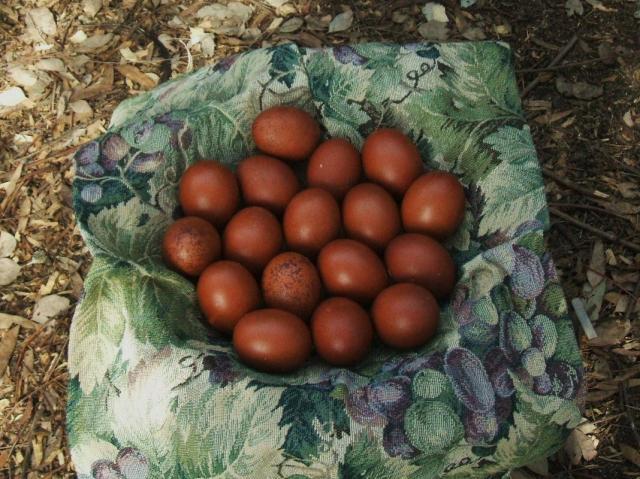
At the Greater California Poultry Fanciers Show-2009
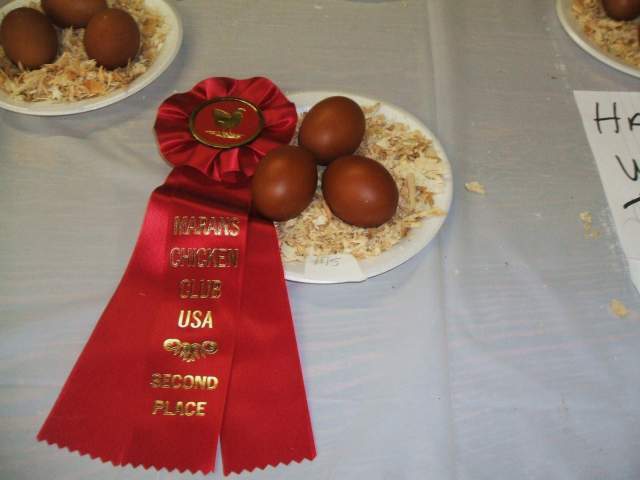
With Easter Egger and Barred Rock Eggs
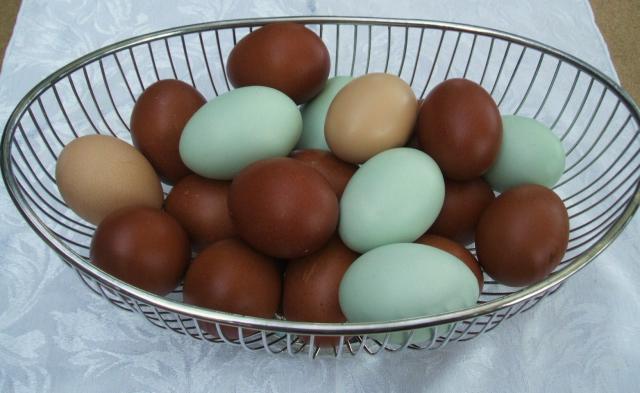
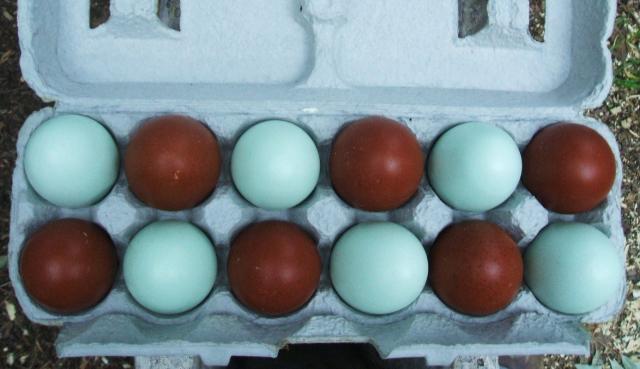
Black Copper Chicks
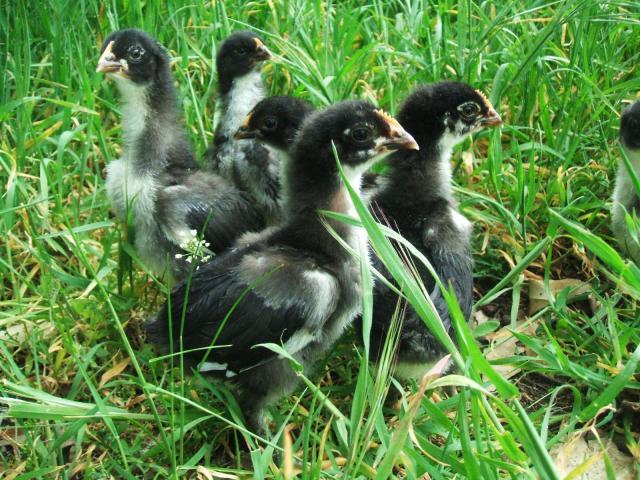
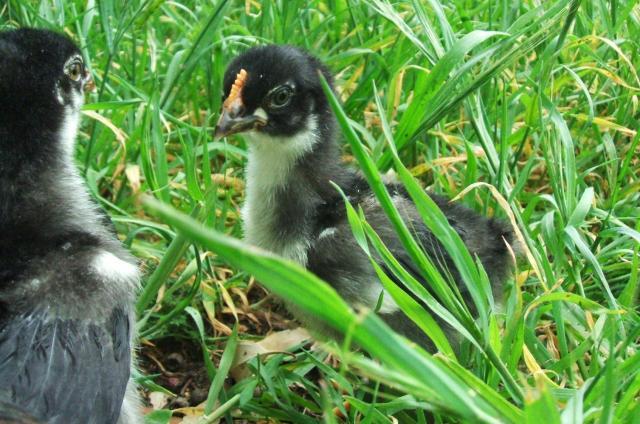

Grazing in the afternoon, 15 Weeks:
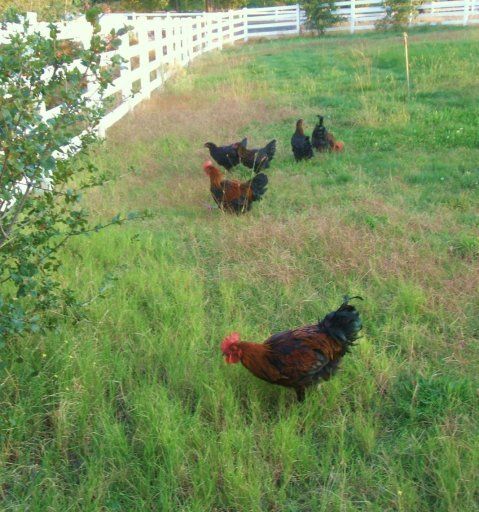
Cockerel 22 Weeks
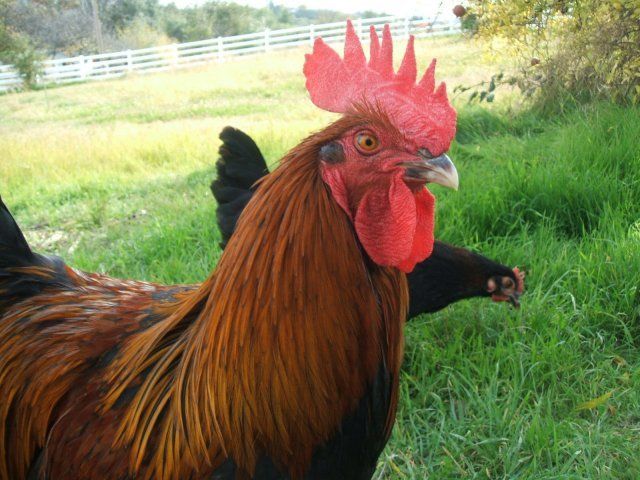
22 Weeks
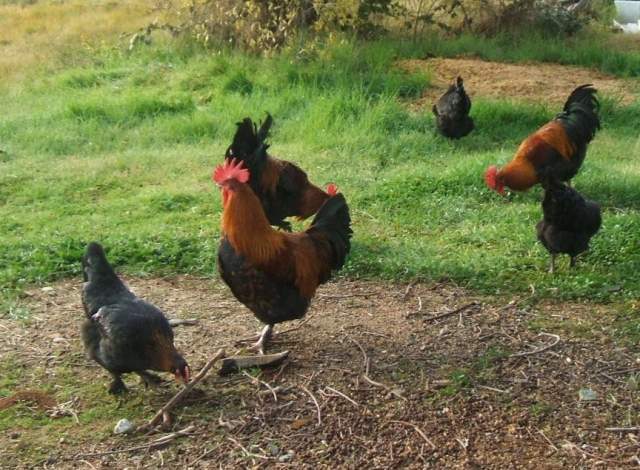
Pullet 23 Weeks
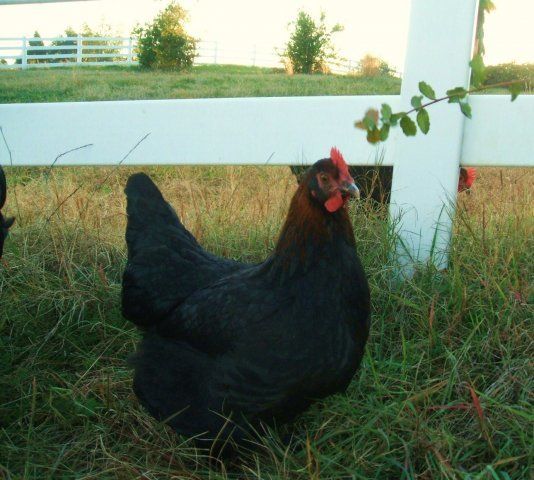
Pullet 23 Weeks
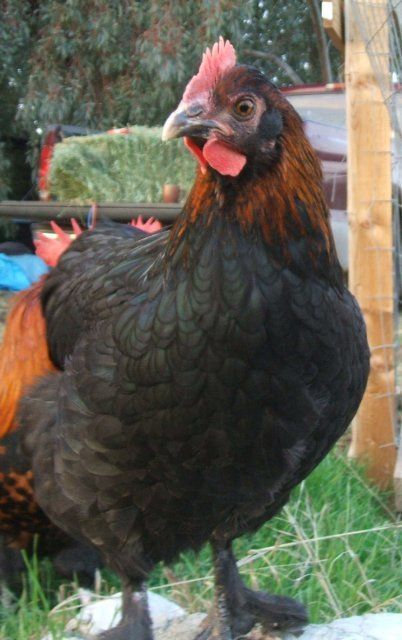
Excerps from the Description of the Brown-red Marans from the Marans Club of France:
Description of the Brown-red Marans
* - the cock must be "black with copper finery, the lancets of the hackle and of the small of the back which are widely copper-red edged, and a black or lightly reddish-brown marked breast."
* - the hen must be "black with not too many glints, with a coppery hackle and a black or lightly reddish-brown marked breast."
The precision of the vocabulary which is used is very important. We can also notice that the hackle mustn't be golden but coppery, that the cock breast is reddish-brown spotted and not enamelled. The hens have a black breast and not necessarly with reddish-brown glints like the cocks because it can create in the end, an unbalance of the Brown-red color due to an excessive dominance of undesirable golden glints on the hen back and wings. So the ideal compromise consists in seeking and preserving by a rigorous selection, a perfect balance between black excess and coppery excess. It must be understood that this balance of the Brown-red color was to be characteristised in the following way in the farmed cocks :
* - a sufficiently strong coppery color (but not excissevely black) and with red-colored shoulders
* - a slightly coppery marked breast
* - a black breast but only if the shoulders and the "ear-tufts" are good
* - orangery-red eyes and quite clear tarsus
As for the hens, the color rule is the same that fot the cocks.
The French Official Standard of the Marans Breed
A- GENERALITIES
Origin- Marans, town of the Atlantic coast, near La Rochelle (France).
Very big, from about 65 grams for young hens to 70-80 grams for adult ones. Deeply dark-brown coloured shell.Characteristics of the eggs to be hatched-
22 millimetres; Cock:
20 millimetres Hen :
Wheight Cock : 3,5 to 4 kilos;young Cock 3,0 to 3,5 kilos
2,6 to 3,2 kilos; young hen: 2,2 to 2,6 kilos Hen:
B – DESCRIPTION OF THE MARANS FOWLS AND AIMS OF BREEDING THEM
Fairly strong poultry, of an average size, plumage close to the body, giving an impression of strength without looking heavy and awkward. The best eggs must be very big and dark-brown coloured.
C – STANDARD
General appearance
Cock
strong, fairly long and wide especially near the shoulders which are highly posted Body-
long, fairly strong, tending to curve in on top towards the skull; the hackles are made of many long and abundant feathers covering the shoulders well Neck-
long, flat, slightly concave towards the rearBack-
large, slightly raised but not rounded, covered with many lancets Saddle-
strong and large abdomen well developed Breast-
short , kept close to the bodyWings-
Tail-strong at its base, quite short, fairly up without going over 45 degrees
average size, slightly flat and long Head-
simple, of an average size, with a fairly rough texture. Sharp edges. The lobe does not touch the napeComb-
average size, red with a fine texture Barb-
average size, red and long -Ear-lobes
red coloured with or without down Face-
bright, with a red-orange iris Eyes-
Quite strong, slightly hooked and horn-coloured Beak-
big, without vulture hocksShanks-
average size, with some feathers; white or lightly pink coloured for all the varieties except for the BLACK and for the BROWN-RED and for the BIRCHEN Marans hens (grey or dark grey). 4 long and well separated toes with the outer one sometimes feathered. The claws are white or horn- coloured Tarsi-
Hen
Smaller than the cock, with a large, strong and more rounded body, a straighter back line, a well developed abdomen , and a fine comb, straight or inclined only in the rear part.
The Brown-Red Variety
(Also called Black-Copper neck, Black Copper, Copper Black & Red Birchen.)
Cock
Black-Breasted Red, with parsimonious red spotting on the breast. Having a black wing triangle. The red markings are not to be yellow or mahogany. Copper coloured lancets in the neck hackle & the back. Deep red shoulders.
Hen
Black with red hackle markings but without the typical Birchen breast lacing. Very slight red breast marking is acceptable. Green sheen is not required
********************************************************************************************************************
